|
Mr. Ante Glibota is the author of two extensive monographs about the artistic achievements of Otto Piene
Otto Piene in the wheel-chair with his wife Elizabeth (in red), his family members, and with Ante Glibota behind him.  With Otto Piene, Mr. Ante Glibota had exceptional honor to participate in the opening of two monumental exhibitions in Berlin, in the Neue National Galerie as well as in Deutsche Bank Kunsthalle on 16th July 2014. 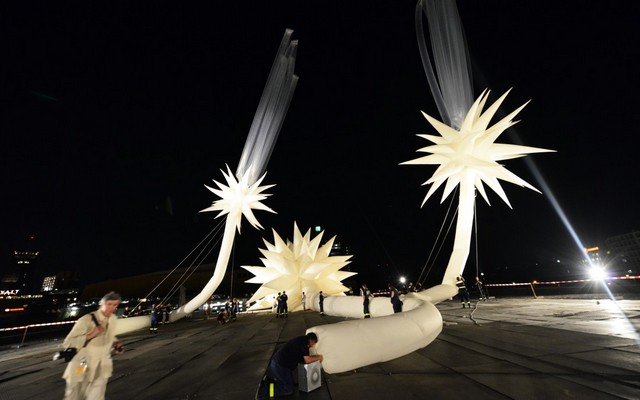 Exhibition in Berlin. Mr. Ante Glibota on the left. Mr. Ante Glibota is the author of an extensive monograph about Otto Piene. Mr. Glibota is also the author of two new books about Otto Piene. 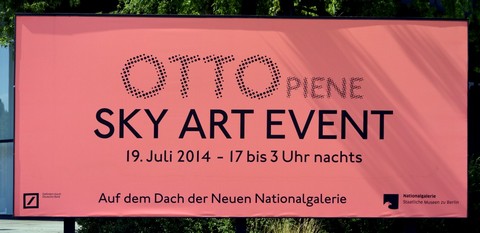 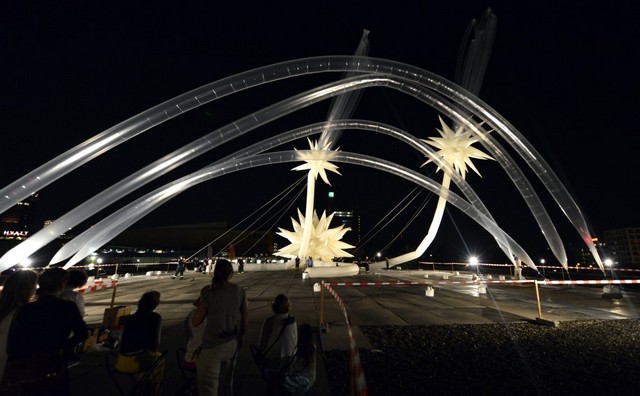 Ante Glibota in the center of the Sky Event Installation of Otto Piene
on the top of the Neue National Galerie in Berlin,19th July, 2014..
From the Introduction to a recently published joint monograph Les nuits d’Héliogabale (Paris) by Otto Peine, Fernando Arrabal and Ante Glibota.
IN THE LIGHT OF POETRY AND GESTURE
by ANTE GLIBOTA 1
"You know that you raised me to such heights and endowed me with such power and dominion as Homer had granted to the great Jupiter"2 so the poet and playwright Fernando Arrabal and the multi-media artist Otto Piene could address each other, invoking the famous exchange between Pliny the Younger and Octavius Rufus. And thus they would echo their mutual compliments over the fruits of their collaboration in this present ‘rare book’ titled The Nights of the Heliogabalus3, consisting of ten magnificent unpublished poems by Fernando Arrabal and eleven captivating lithographs by Otto Piene, that now have become one.
These two major figures in the worlds of fine arts and literature have joined together here in an unprecedented creative gesture. Arrabal and Piene, each in their respective fields, belong undeniably to the creative avant-garde of our time. Both have at their disposal a multitude of artistic, literary, sculptural and philosophical expressions that unites them in their creative essence and their pursuit of a consummate art, one that is ingenious, indivisible and without limits.
Close in age they have each created for themselves their own environments that profoundly nourish and highlight the amplitude of the waves that radiate through the breadth of their creativity and their artistic, literary, sculptural and multi-dimensional achievements. Yet all the while they are still disposed to and engaged in the celebration of playful creative endeavors. Both are exiles, tireless travelers, or perhaps artists-writers who are endowed with the strength and perseverance that transforms the experience of the voyage into an experience of life, into the creative act that defines their unique position.
Fernando Arrabal, together with Eugene Ionesco and Samuel Beckett, perpetuates into our times that cardinal, undisputed and indivisible trilogy in the global dramaturgy of the second half of the 20th century, with some one hundred plays on which the sun never sets as they are performed in all four corners of the globe. With a dozen cult films that mark the spirit of our time, as well as with his remarkable outpouring as a novelist and poet, he offers us a wealth of reflections and a veritable philosophy of sentiments summoned in an oeuvre of writings, films, paintings, sculptures and photographs, as the achievement of a possible consensus between the creative acts and the conclusion reached therein.
The philosopher speaking on anything and everything with his own science and with precipitant intuitions constitutes the anchor of Fernando Arrabal’s universe. His language, the capricious movement of bodies rhythmatized by sudden bodily and verbal pirouettes, captures one’s memory. It reveals an oratory genius, marked by a French- Iberian charm, tainted by a “British accent”, as he calls it laughingly in self-depreciation, who has seduced a many. Yet while he indulges in talking about many things, passing from one subject to another, it is never as if he were speaking fleetingly and superficially. Instead he always plunges into profound depths, as his ten poems on Otto Piene amply demonstrate.
History has played tricks on him, travesties of vicissitude in his particular case and his personal journey. But Fernando Arrabal has played tricks on history himself through the metamorphoses of his life - his pains, his sufferings, his passions, his dreams and his excesses that were so timely - part-foreboding, part-defiance - finding expression in his poetry and plays, in his prose and sculpture, thus creating a reflective mirage, a vast oeuvre of eternal virgin forest.
Otto Piene, on the other hand, has marked the European post-war avant-garde by founding the group "Zero", together with Heinz Mack and later Günther Uecker, and by posing the essential question about a vision of tomorrow’s art and pursuing new paths in which the important artists of the 20th Century would follow and regroup themselves, artists such as Lucio Fontana, Yves Klein, Piero Manzoni, Jean Tinguely, Daniel Spoerri, Jesús Rafael Soto, Enrico Castellani, Pol Bury, Arman, Christian Megert, François Morellet and Piero Dorazio..., opening new vistas and new perspectives in support of an aesthetic coherence.
The reunification of European artists around an artistic project represented in fact not merely the creation of the group "Zero" but also the point-zero of recreating a Europe of the arts through the presentation of its most creative performances and advances, in an effort to bring together the peoples and nations divided after the disaster of the Second World War. They tried by the most pertinent means, through the message of art, to gather the young creative people, to bring them together in order to make them receptive to the pursuit of the joy and celebration of peace, and to sharing in a future prosperity and universal harmony.
In fact, the group "Zero" itself was at the same time the seed as well as the nucleus for a European resurgence from that point zero of calamity, suspicion and guilt. That very moment became a moment of hope through the willingness to release the German people from their quarantine, destruction and psychological turmoil, by allowing them to rejoin the ranks of great nations through their artists, with the support of all the most important artists in the European avant-garde of the time.
The group "Zero" became Europe; it became in a sense the spontaneous foundation of a Europe of the Arts, as it had never existed institutionally or politically. The importance and the significance of the group "Zero" was recognized for reasons of the movement‘s aesthetic and creative innovativeness.
Still today, more than fifty years after its founding in 1958, major museums4 in the world arrange extensive retrospective exhibitions of the members of the group, in order to demonstrate its importance and its contribution to the development of the artistic landscape of its time, as well as its ability to define the development of the arts in times to come.
Otto Piene, not interested in exploiting his artistic, creative, organizational or commercial achievements, chose not to pursue those successes. He instead preferred to go on the road and cross the Atlantic for the United States, to turn to new frontiers for integrating into his sculptural and multi-medial research science, technology and outer space as new areas for experimentation and vision.
By founding the "Sky Art" movement, an art devoted to the expanses of the universe and the billions of human inhabitants, he has opened new frontiers calling for "More Sky", a prophetic work that had already been a part of his series "Flying People" realized in 1951-1952, and then of his "Light Ballets" created in his ‘experimental studio’ in Düsseldorf in 1957 that contained, in Piene’s mind, pocket universes or ‘maquettes of the universe’ that he had imagined and prefigured then with limited resources.
Otto Piene moved to the United States in 1964, working first at the University of Pennsylvania and later at the Massachusetts Institute of Technology (M.I.T.) in Cambridge, MA, where he became the director of the Center for Advanced Visual Studies (CAVS), an institution that he headed for 25 years and that will continue to be an important place for global research and development and for the debate and dissemination of visual ideas at the intersection of art, science and technology.
In his work at M.I.T. Otto Piene asserted himself as artist, educator, theoretician and philosopher-aesthetic, as “front runner” of the "Sky Art" movement through his sky events and his happenings that resonated in the international art scene. There can be no doubt about the linkages between the group "Zero" and the "Sky Art" launched by Otto Piene; they are self-evident indeed. One can clearly sense in both the creative atmosphere surrounding an artist who has consciously developed and sowed in his wake and throughout his artistic career the concept of a participatory art as an indispensable and vivid art form, as the philosophy and creed of an advanced artistic universe and as a creative, vibrant, poetic and inspiring experience.
Fernando Arrabal in his ten magnificent poems, quite literally, ‘plunges’ deeply into the very essence of Otto Piene’s work, into all the richness and exhaustive complexity of his art and the many pioneering activities that have opened new perspectives and venues for contemporary artistic pursuits. Piene, as precursor of the German avant-garde after WWII, will be remembered as one of the most prolific explorers in the field of light, as the best heir to those exploits already initiated by the Bauhaus, as one who at the same time left his indisputable imprint on many of the new experiences and innovative expressions in the arts.
In the luxurious poems of Arrabal Piene is anointed the swallower of light, the explorer of abysses, of volcanoes or miniature cosmoses, thus setting forth the extent of his labyrinthine oeuvre, his explorations of the illusions of light, of fire, of the celestial infinitude, of nothingness, in order to unlock through his creative gesture the cosmic light that allows us to comprehend the unity of history, to understand its internal course as a state of mind and an act of creativity.
Arrabal is quite familiar with Piene’s work with fire that he reflects on in his poems. The fire in its poetic and mythic form is luminous and consuming. In its divinatory and symbolic form it takes on a cleansing significance and evokes a spiritual meaning of the extremes between heaven and hell.
The poetic language used by Arrabal is judiciously erudite, echoing an ambitious quest, pursuing a dialogue and aspiring to a liberated gesture capable of decoding and penetrating the sculptural language of Piene that filters and tempers with innate sensitivity, thus facilitating the objective of interpreting the poet’s true and immutable essence. The poet wonders about how to translate into poetic language that casual and congruous precision, the promptitude of the sculptural gesture, so wise and so rich at the same time - classicist one might say - timeless and totally liberated, profoundly subtle and of a euphonic pliancy, while always reflecting the modernity of the distinctive Arraballian imprint.
The central motif of these ten poems is the light - that which envelops the mysterious and the intimate - associated by Arrabal with Piene’s color scheme in the form of a rainbow. Those brushstrokes reappear as lightning, as the glittering fire of a burnt canvas, with a magic evoking the dream of a holy rite that turns the bodily into the spiritual, revealing illuminated peaks in an endless ocean, reflecting in the light of the glistening waves the mountains and the epileptic nature in its choreography.
The complicity between the images and words of Piene and Arrabal is self-evident. Arrabal plunges into Piene’s emblematic works, while Piene translates through his sculptural gesture the language that inspires Arrabal’s poetic cadence. They thus achieve a beautiful poetic-visual entente based on a shared fervor that is responsible for achieving the resounding success of these two parallel artistic experiences.
In his series of eleven lithographs that accompany the poems by Fernando Arrabal, Otto Piene unveils his modus operandi. The artist, through a graphic and pictorial gesture, seeks to restore the harmony in the human environment using basic forms, powerful and full of meaning, although he sometimes plays on the complexity of surrealist forms in order to come closer to the Arrabalian spirit.
Piene contemplates Arrabal’s poems prior to accompanying them with his clear and simple gestures. He comes back with sparing means of form and color, utilized in just the way the Arrabalian poetic cadence requires. Neither too much nor too little, as the Protestant rigor dictates! That could indeed be one of Piene’s artistic and existential creeds, a measure that the artist himself attributes to his work when he affirms: “in order to demonstrate the relevance on which one insists we do disclose the very mental processes in the development of these projects, be they installations, sky events or sculptures...” Thus they appear as a succession of intuitive and profound evidences of his creativity. The sequence exposes a state of mind in which ideas find clear and evident conceptual as well as visual realization.
Manfred Schneckenburger is correct in pointing out that Otto Piene “has transformed the classical canvas into an instrument capable of capturing, structuring and expressing in nuances an immaterial optical energy. But he was at the same time the organizer - or the magician? - of the elements, of fire, air, and light, the rationally calculating organizer who operated circumspectly and methodologically. He became the most exacting artistic strategist who managed the various cross currents involving the new processes allowing for the inclusion of light, smoke and fire in the creative process.”5
It is exactly that creative continuity that has helped me to discover that extraordinary amplitude and unique character, through close observation throughout our “voyages”, at times living in close proximity to both the protagonists of this book, and through our shared adventures beyond those voyages, continents and spaces so diverse.
Otto Piene has created these lithographs by drawing directly on the plate without any intermediary, thereby exacting with great precision the cadence and chromatic choices. The luminous transparency, the equilibrium and effluence, and the ontological meditation, provide a new dimension of freshness, playfulness and plasticity, imbued with that breath of silence that the artist religiously maintains during the execution.
The mastery of the lithographic studio of Stephane Guilbaud in Paris, where the edition was printed, has contributed equally to the optimal result. We have worked with Stephane Guilbaud for many years with exceptional results that confirm his preeminent position in that technique and art form, a position that he retains without question at both the French and European level.
In conclusion, we are fortunate to have had the partnership with Jorg W. Ludwig for this volume. He has provided the translations into English and German, not only of the poems but also of this introductory text, adding to the pleasure that this book may render through the elegant flow of his choices of language and rhythms streaming like water from a fountain. Even the language of Arrabal, who has introduced into his poetic meter an echo of antiquity, when translated here into other languages, keeps flowing like a river that harbors the hue of time. Piene’s forms and Arrabal’s cadenced prosody are thus kept in an irresistible vertigo.
Paris, June 15th, 2014 (v): 1st Gidouille, 141 of E’P.
1 Historian of art and architecture and Titular Member of the European Academy of Sciences, Arts and Letters.
2 Letters of Pliny the Younger, Book I, VII, edited by Garnier Freres, Paris, 1920.
3 Delight Editions, 2014.
4 The Neue Nationalgalerie Berlin and the Deutsche Bank Kunsthalle in Berlin present concurrently from July 16, 2014 two exhibitions of Otto Piene. Another Otto Piene exhibition is being shown at the Langen Foundation in the context of the Düsseldorf Quadriennale (April -August 2014). The Guggenheim Museum in New York is devoting an exhibition to the Group Zero, beginning October 10, 2014, that will travel to the Stedelijk Museum in Amsterdam and to the Martin Gropius Bau in Berlin from March 2015.
5 Manfred Schneckenburger, Otto Piene, Bilder und Lichtballett, published in the catalogue of Galerie Schoeller, Düsseldorf, 1987
| 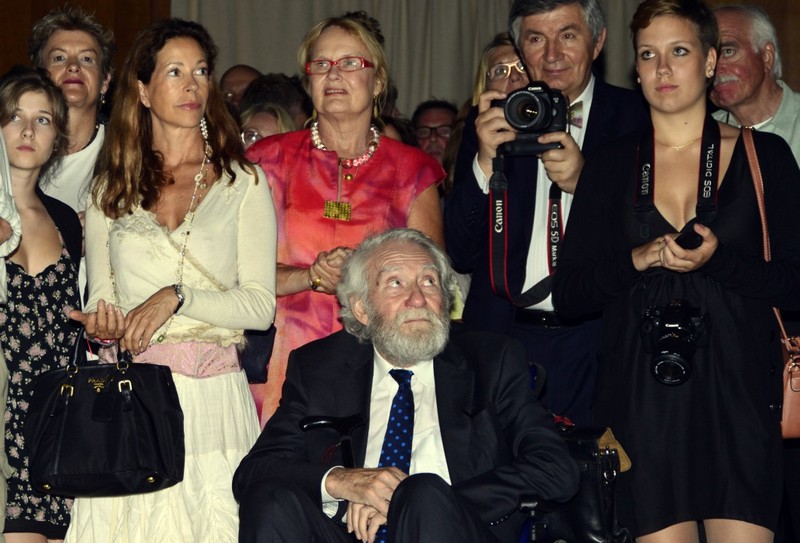 Otto Piene in the wheel-chair with his wife Elizabeth (in red), his family members,, and with Ante Glibota behind him. 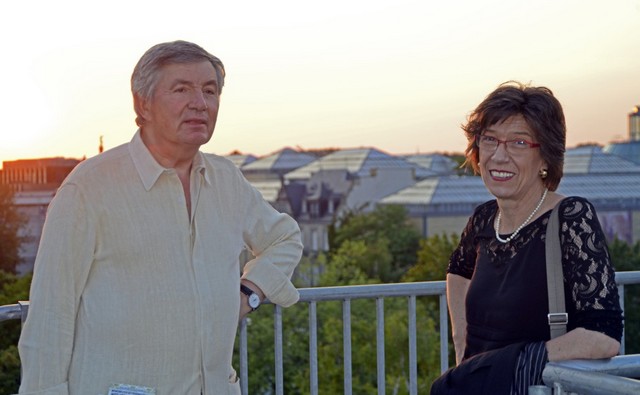 Ante Glibota and Otto Piene's daughter Claudia, on the top of the Neue National Galerie in Berlin,
19th July , 2014, looking at the Sky Event installation of Otto Piene.
Dieter Jung, German hologram artist, Dr Christina Quadt from Munich and Ante Glibota on of the Sky Event
installation of Otto Piene in the Neue National Galerie in Berlin, 19th July, 2014.
Many thanks to Mr. Ante Glibota for sending us the text and photos.
Formated for CROWN by Darko ®ubriniæDistributed by www.Croatia.org . This message is intended for Croatian Associations/Institutions and their Friends in Croatia and in the World. The opinions/articles expressed on this list do not reflect personal opinions of the moderator. If the reader of this message is not the intended recipient, please delete or destroy all copies of this communication and please, let us know!
|